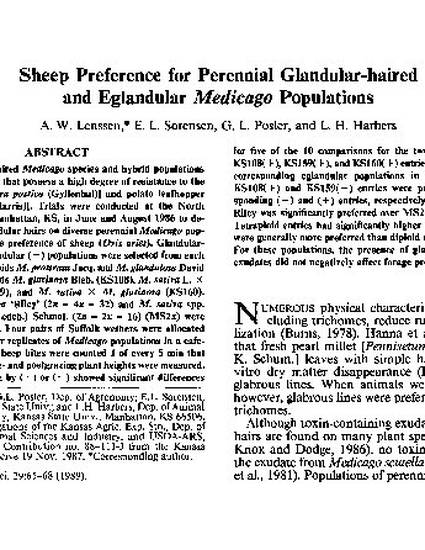
Erect glandular-haired Medicago species and hybrid populations have been developed that possess a high degree of resistance to the alfalfa weevil [Hypera postica (Gyllenhal)] and potato leafhopper [Empoasca fabae (Harris)]. Trials were conducted at the North Agronomy Farm, Manhattan, KS, in June and August 1986 to determine if erect glandular hairs on diverse perennial Medicago populations affect forage preference of sheep (Ovis aries). Glandular-haired (+) and eglandular (−) populations were selected from each of the following: diploids M. prostrata Jacq. and M. glandulosa David (KS94) and tetraploids M. glutinosa Bieb. (KS108), M. sativa L. ✕ M. prostrata (KS159), and M. sativa ✕ M. glutinosa (KS160). Eglandular M. sativa ‘Riley’ (2n = 4x = 32) and M. sativa spp. caerulea (Less, ex Ledeb.) Schmal. (2n = 2x = 16) (MS2x) were included as controls. Four pairs of Suffolk wethers were allocated randomly among four replicates of Medicago populations in a cafeteria grazing trial. Sheep bites were counted 1 of every 5 min that grazing occurred. Pre- and postgrazing plant heights were measured. Populations differing by (+) or (−) showed significant differences for five of the 10 comparisons for the two grazing periods. The KS108(+), KS159(+), and KS160(+) entries were preferred to their corresponding eglandular populations in the June period. The KS108(+) and KS159(−) entries were preferred to their corresponding (−) and (+) entries, respectively, in the August period. Riley was significantly preferred over MS2x in the August period. Tetraploid entries had significantly higher initial plant height and were generally more preferred than diploid entries for both periods. For these populations, the presence of glandular hairs and their exudates did not negatively affect forage preference by sheep.
Available at: http://works.bepress.com/andrew_lenssen/9/
